Tidbit #1-When was the Regency period?
The Regency Period is the time during 1811-1820 when King George III was unable to reign and his eldest son became Prince Regent. The future George IV was not well-liked by his countrymen. His debts, extravagances, and his public separation from his wife made him unpopular. He was often caricatured in the newspapers as a dissolute and profligate man who gorged on food, while the common class starved unable to earn a decent wage; however, his love and self-indulgence for dressing well and owning beautiful things brought fashion and art into style in the 1800's.
Source: The Lives of Kings and Queens of England by Antonia Fraser p.285-291. The Prince of Pleasure and his Regency by J. B. Priestley. George IV by E. A. Smith p. 132; 167. Royal Panoply by Carolly Erickson p. 266.
Tidbit #2-What does aristocracy mean?
Aristocracy refers to a class of persons holding exceptional rank and privileges. During England's Regency period this class referred to members of the peerage: dukes, marquis, earls, viscounts, barons, whose bloodline (heredity) bestowed upon them their title and guaranteed their seat (voting right) in the House of Lords, the upper house of Britain's Parliament. Aside from owning wealth and property, their biggest privilege was their right to be tried for a felony in the House of Lords versus a court of law.
Source: Dictionary.com. What Jane Austen Ate and Charles Dickens Knew by Daniel Pool p.35.
Tidbit #3-What is primogeniture?
Primogeniture, the right for the firstborn son to inherit the entire estate, was almost universally practiced among the landed families of England in the 1800's in order to maintain their family's power and wealth, generation after generation. The goal was for an estate to be passed without being split up among several children and sold off. This left second, third, fourth sons to make their own way, usually in a military or church career, and daughters to marry as well as possible. An entail kept first born sons from diminishing his inheritance by restricting his right to sell or mortgage the estate. Only the income from the land and the use of the property was his for his lifetime. This proved a problem when the estate did not produce enough funds to maintain itself, leaving many landed gentlemen in debt and in need of marrying an heiress.
Source: What Jane Austen Ate and Charles Dickens Knew by Daniel Pool p.90.
Tidbit #4-The Season
During the Regency period, the Season began with the opening of Parliament in January. Lords came to London to take their seat in the House of Lords and as soon as the weather improved, their families joined them to indulge in the shopping, parties, and events, from April through June, that marked the height of the Season. Daughters and sons were presented at court and then attended a myriad of balls, soirées, concerts, dinners, and other amusements. Sons came of age trying their mettle at clubs and other pleasure pursuits, while daughters showcased their wares in the hope of securing a titled and wealthy husband. The social events of the Season comprised the marriage mart because it was the only time that great numbers of wealthy and titled young men and women were brought together from all over England. When Parliament closed, noble families left London for their country estates. Some returned to London to partake in the Little Season that ran September until till Mid-November, but most did not return until April.
Source: What Jane Austen Ate and Charles Dickens Knew by Daniel Pool p.52. Georgette Heyer's Regency Word. by Jennifer Kloester p.85.The London Season by Michelle Jean Hoppe www.literary-liasons.com/article 024.html.
Tidbit #5-Gambling
Gambling and betting were a major preoccupation during the Regency Period. From the high-end gentleman's private clubs on St. James Street to the lower end hell clubs, vast fortunes were lost from playing cards to the roll of the dice. It was implicitly understood among nobility that gambling debts were debts of honor and took precedence over any other debt. A man's honor was at stake if he failed to pay a gambling debt, but an outstanding debt to a tailor or tradesmen did not impugn his character. It was not unheard of for merchants to wait months, even years, before they finally were paid for merchandise and services received.
Source:Georgette Heyer's Regency Word. by Jennifer Kloester p. 265. Beau Brummell by Kathleen Campbell p. 99-100. The Regency Underworld by Donald A. Low p.123-148.
Tidbit #6-The Blue Stocking Society
A debutante during the Regency period spent most of her day ensconced in social visits, shopping, and honing the talents that were the mark of a lady, like painting watercolors, playing the piano, and stitching embroidery. A woman who read to improve her mind was usually frowned upon, as intelligence was considered a masculine trait. Even so, women's literary groups, known as The Blue Stocking Society, sprung up in the 1750's. At the time, the misnomer was attributed to Benjamin Stillingfleet, a respected botanist, translator, and author. He was a frequent and admired guest of Elizabeth Montague's and Elizabeth Vesey's literary group. It is said Mr. Stillingfleet was unable to afford the proper formal dress of black silk stockings, so he wore his everyday blue worsted stockings to the meetings. James Boswell, in his book, The Life of Samuel Johnson, records, "Such was the excellence of [Stillingfleet's] conversation that his absence was felt so great a loss that it used to be said, 'We can do nothing without the blue stockings.'"
Source: New Illustrated Columbia Encyclopedia: bluestocking p. 827. Clubs and Club Life in London by John Timbs p.170-171.The Life of Samuel Johnson by James Boswell p.277.
Tidbit #7-The Calling Card
The Calling Card was a necessary tool for making social calls where, among the upper echelons of society, servants opened and screened visitors at the front door. The protocol kept social aspirants at bay. As soon as a family returned to London for the Season, the lady of the house would make her rounds to drop her card off at homes to announce her family's arrival. She would wait in her carriage while her groomsman knocked on the door to present her card to the household's servant. The cards were made of quality paper with simple engraved type and were smaller than the 9x6 cm card of the Victorian age. Lady's cards were larger than a gentleman's because his was sized to fit into his breast pocket.The cards were stored in beautiful cases made of various materials like silver or ivory. The person's name and title were printed on them and some cards had printed on the reverse side of the corners, the words: Visite, Felicitation, Affaires, and Adieu, so that when turned down, the mistress of the house understood the visitor's purpose. If the mistress of the house was home, the servant would take the card to her to see if she would receive her caller. If the mistress had no interest in receiving the caller, then the servant returned the card and informed the visitor that his mistress was not at home. The caller understood immediately that she was snubbed. For this reason, some ladies sent their grooms to simply drop of their calling cards, so that no affront could be made to them and they could hope that their visit would be returned. If the mistress was truly absent, then the servant would take the card, turning down its corner to indicate it was delivered in person and placed the card on the silver salver in the entry-way for their mistress to see. Servants always displayed the most prominent cards on top to boast of the household's esteemed connections.
Source: What Jane Austen Ate and Charles Dickens Knew by Daniel Pool p.66-69.The Etiquette of Using Calling Cards by Vic May 21, 2007
http://janeaustensworld.wordpress.com/2007/05/21/the-etiquette-of-using-calling-cards/.Paying Social Calls By Laura Boyle | Published: June 20, 2011 http://www.janeausten.co.uk/paying-social-calls/.Paying Social Calls http://www.worldmags.com /magazine/page.ihtml?pid=642&step=4
Tidbit #8-Driving a Team of Horses and the Four Horse Club
A gentleman who could drive his cattle (team of horses) and a four wheeled carriage with speed and precision was remarked to be a "capital whip" or "top sawyer." Young gentlemen as sport, who did not own their own coach, would often pay to take over the reins of a public stage, to test their skills at managing a team of four horses. The often young, noble, and reckless men tried their hand at guiding the double team of horses around corners, in passing other vehicles, and letting them loose on long stretches of road, much to the horror of its paying passengers. It was the ambition of these young lords to become a Four Horse Club (Four in Hand) member where only the best drivers were asked to join. Membership was by invitation only, limited, and therefore highly coveted. Four times a year, these "top sawyers" made quite a spectacle when driving their team in a fast trot, single file, twenty miles to Salt Hill, where they ate lunch before making the return trip to London the following day. Their yellow painted barouche and distinctive uniform, that included a one inch blue and yellow striped waist coat, identified their membership in the exclusive Four Horse Club.
Source: Georgette Heyer's Regency World by Jennifer Kloester p.169. http:// homepages.ihug.co.nz/~awoodley/regency/club.html p. 3-5.
Tidbit #9-What is the "Delicate Scandal?"
Scandal was one of Society's best forms of amusement during the Regency period unless the imbroglio had to do with one's own family. A peer's fall from respectability gave the gossipmongers something to talk about during their social calls and if the transgression occurred at one of their own balls or soirees, then all the better, because nothing assured a party's success like a peer behaving badly. Disgraced nobles and politicians suffered embarrassment when artists like George Cruikshank and James Gillray caricatured them for the local print shops and tabloids. In 1820, one of the great scandals, where the king tried to divorce his queen by proving she was an adulterer, was referred to as the "Delicate Investigation." Cruikshank drew the new reigning King George IV and his long-estranged wife, Caroline of Brunswick, encased in side by side green tote bags. The satirical picture implied the king was as much an adulterer as his wife, since he was reported to bring his evidence against Caroline to court in a green bag.
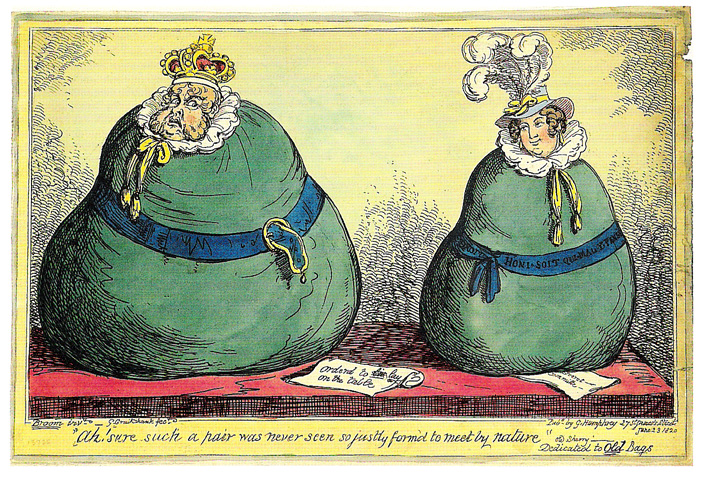
The Delicate Investigation-George had no wish to see the wife he hated crowned as his Queen Consort, so he accused her of having a child out of wedlock so that he could divorce her. Adultery was the only grounds for divorce and since he was as notorious as his wife for having affairs, he hoped to secure a dissolution of marriage by proving the boy his wife had taken into her custody was her illegitimate son. He was reported to bring his evidence to court in a green bag. A very public investigation led by the Prime Minister Lord Grenville found no evidence to prove the boy Caroline adopted was her own, so no divorce was granted. Regardless, the king kept Caroline from being crowned at his coronation by placing guards at every entry at Westminster Abbey to keep her out.
Source: Prinny and His Pals by Tom Ambrose-see centerfold prints. The Prince of Pleasure and his Regency by J. B. Priestley p. 16, 163 see index for more plates. Georgette Heyer's Regency World by Jennifer Kloester p. 101-104. George IV by E.A. Smith, p. 113.Caroline of Brunswick, Wikipedia
Tidbit #10-Who was Beau Brummel?
George "Beau" Brummell brought cleanliness and simple elegance into fashion during the Regency period. He was the first man to wear black evening dress. Before Beau, the style of flamboyant clothes with frills, lace, and colors were popular, but Beau's friendship with the Prince Regent who admired his daily bathing and dressing habits, made him an arbiter of fashion when the future king began to copy his ways. Before Beau's influence, most of the commonwealth believed if they submersed their bodies to bathe that they would catch the ague (lung inflammation), especially during the frigid winter months, so instead, they used heavy colognes to mask their body odors, and wigs or turbans to cover their soiled hair.
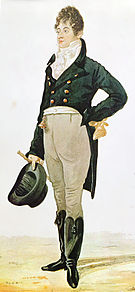
1805 caricature of Beau Brummel by Richard Dighton
Source: Prinny and His Pals by Tom Ambrose p.60-66. The Prince of Pleasure and his Regency by J. B. Priestley p. 48-50. Dr. Johnson's London by Liza Picard p. 227-228. Beau Brummell by Kathleen Campbell p. 54
Tidbit #11-Who was Gentleman Jackson?
Pugilism (boxing) was a popular sport amongst the gentlemen during the Regency Period. In 1795, John Jackson, in his third fight, defeated Ben Mendoza for the British championship. He was the first to draw blood with a cut over Mendoza's eye in the fourth round and in just ten and a half minutes, the 5'11" 203 lb boxer, knocked him out in the ninth round. Jackson retired after the fight and opened an exclusive boxing salon on 13 Bond Street. The lords liked his salon where they could spar with gloves, but mostly because Jackson coached them on what to do and what not to do. He became known as "Gentleman Jackson" for his impeccable manners and greatly admired for his ever evolving knowledge on boxing.
In 1814, he formed the Pugilistic Club in an effort to clean up the sport and earned further fame when the Prince Regent asked him to provide 18 bodyguards for his coronation.
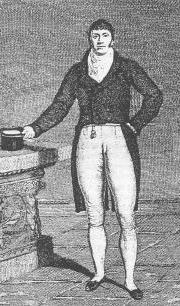
Gentleman John Jackson
Source: Bare Fists. The History of Bare-Knuckle Prize-Fighting by Bob Mee p. 41-43. Georgette Heyer's Regency World by Jennifer Kloester p.256-257
Tidbit #12-The Waltz
The Waltz was frowned upon by the upper echelons of society during the Regency period until Czar Alexander of Russia brought it into fashion by dancing it at Almack's in 1814. At the time, dancing was a group affair where men and women lined up opposite one another and waited until it was their time to join their partner in the set to complete figures and promenade. The country-style dance left little room for conversation or impropriety as couples were more apart than together. The Waltz introduced an opportunity for couples to dance in close proximity and engage in unchecked conversation. There was such concern that the dance would subject a young debutante to unwanted attention or worse yet, slander her reputation that permission from the Patronesses of Almack's was required to dance it. The lofty patronesses who governed the assembly room granted permission only if they deemed the gentleman making the request was a suitable partner for a newly come-out debutante.
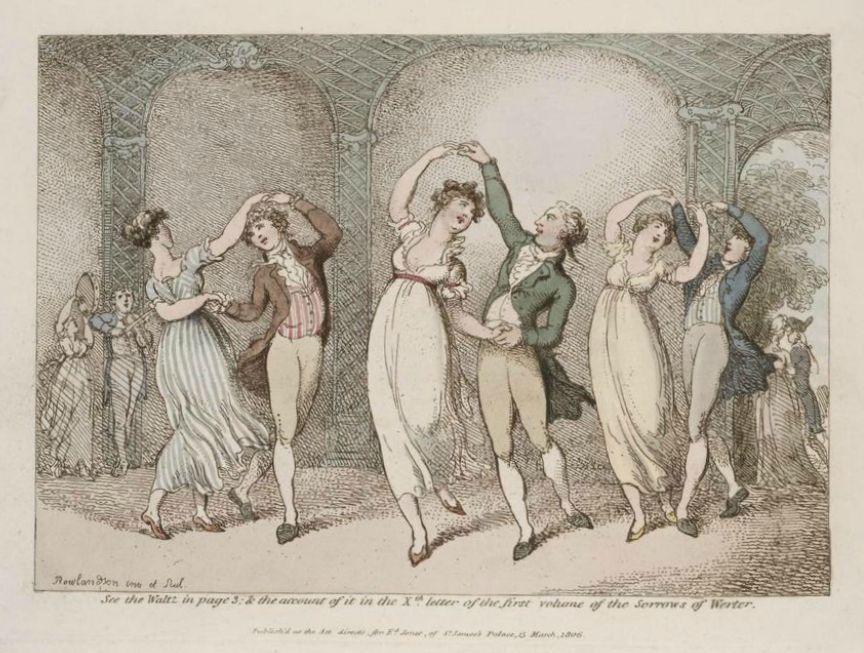
Thomas Rowlandson's caricature of the waltz in 1806
Source: Georgette Heyer's Regency World by Jennifer Kloester, p.105. What Jne Austen ATe and Charles Dickens Knw by Daniel Pool, p.60-61. https://www.jasna.org/persuasions/on-line/vol30no2/smith.html. https://janeaustensworld.wordpress.com/tag/regency-dance. https://philadancehistoryjournal.wordpress.com/tag/regency
Tidbit #13-The Walking Stick
The walking stick crafted from cane wood (hence, the term "cane") imported from the Strait of Malacca in Malaysia and usually topped off with a knob made from precious metals was a symbol of wealth and status for the Regency gentleman. It was an expensive fashion accessory that the common man could ill afford. It was made from a smooth wood with a glossy brown finish that was harvested from the stem of a rattan palm. The knob (crafted from gold, silver, or ivory) was often times adorned with jewels. Some gentlemen commissioned knobs to be shaped as an animal head or an automaton where the head moved upon the touch of a button. The hollow sturdy cane could be fashioned as a sheath to house anything from an umbrella to a weapon. Since the 17th century, many gentlemen discarded wearing a heavy sword at their waist to carrying a walking stick (with a blade hidden inside) for protection.
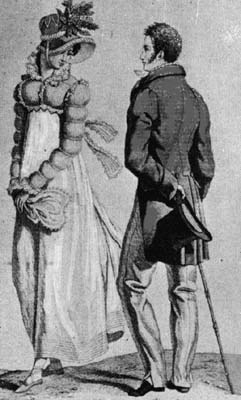
Circa 1812
Source: www.thestickman.co.uk/the_history_of_walking_can.htm. http://fashion-history.lovetoknow.com/fashion-acessorites/canes-walking-sticks. http://canequest.com/malacca.asp
Tidbit #14-White's
Opening in 1698, White's is the oldest exclusive gentleman's club in London. It originally opened as a public chocolate house before establishing itself as a private club where it required dues. The earliest record of members is dated 1736. In 1755, it moved to its current location at 38 St. James Street in London where it remains a strictly male club. During the Regency period, a committee of members cast their vote by throwing a white marble into a ballot box to approve an applicant. It only took one black marble to deny membership. Club members were primarily lords belonging to the conservative Tory party. They drank; played billiards and board games (like chess); gambled (mostly hazard and faro); made wagers and enjoyed a good meal. White's betting book was renowned for recording wagers on anything from births, weddings, deaths, to the absurd (like the speed of a raindrop falling down a window pane). In March 1798, one entry read, "Mr. Brummell bets Mr. Osborne twenty guineas that he (Mr. B.) is married before him (Mr. O)." Mr. Brummell lost the wager.
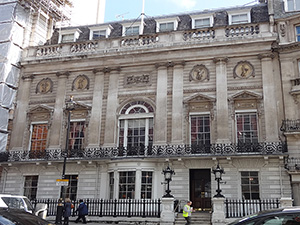
White's Gentleman's Club
Source: Clubs and Club Life in London by John Timbs p.92-103. Georgette Heyer's Regency World by Jennifer Kloester p.120. Beau Brummell by Kathleen Campbell p.45-47, 59, 90. Travelers in Eighteenth Century England by Rosamond Bayne-Powell p. 53-54
Tidbit #15-Gunter's Tea Shop
Gunter's located on 7-8 Berkeley Square during the Regency period, besides being popular for its delicious ices and sorbets, was a place where a gentleman could take a lady without benefit of chaperone. The confectioner's shop catered to the nobility. Gentlemen would take their ladies on a ride through Hyde Park in the late afternoon. They would often stop to park their open carriages under the shade of Maple trees along Berkeley Square and place an order with the waiters that rushed across the road from Gunter's to serve them. It was quite acceptable for the man to stand by the lady and singularly enjoy her company without harming her reputation while she sat in his carriage eating her ice. Domenico Negri, first owned the shop named The Pot & Pineapple. He took James Gunter on as partner in 1777 and by 1799, Gunter had sole proprietorship. He renamed the business Gunter's and with a large ice house in the cellar, he could offer an array of ices and molded delicacies that made him fashionable with the ton who ordered his exquisitely designed desserts for their parties. A favorite dessert of the Prince Regent was known as "Nesselrode Pudding." The confection was an ultra-sweet iced puree of chestnuts, mixed with beaten eggs, and a mountain of whipped cream, laced with complicated sweets, and ices. Gunter left a thriving business for his family that continued to prosper for generations.
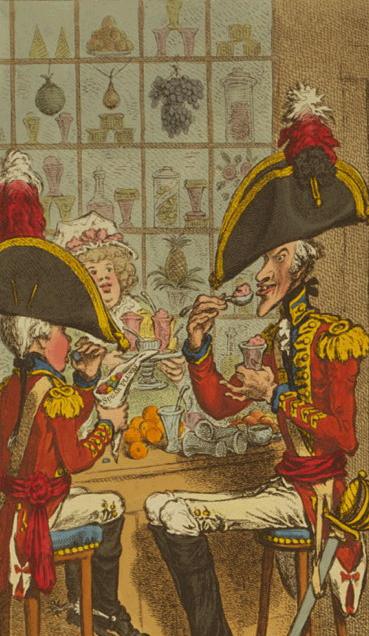
1797 James Gillray caricature of soldiers eating ice in a confectioner's shop
Source:Georgette Regency World by Jennifer Kloester, p.247-248. An Elegant Madness by Venetia Murray, p. 193.http://www.georgianindexnet/Gunters?gunters.html. https://janeaustensworld.wordpress.com/tag/gunters-tea-shop/
Tidbit #16-The Tower Menagerie
The Tower Menagerie (exotic animals on display in the Tower of London) was an entertaining curiosity for the royal family, their guests and later, when the Tower stopped being a royal residence, for the paying public. In 1235, the Holy Roman Emperor, Frederick II gifted King Henry with three lions to celebrate his marriage to Henry's sister, Isabella. Over the centuries, the Royal menagerie grew with other gifts from kings and queens of faraway lands, as well as, from expeditionary groups (like those led by Captain Cook) and the East India Company who traveled the world for scientific finds. The death rate on these animals were high as little was known on how to care for them. The Napoleonic Wars prohibited the scientific travel that would have replenished the dying animals and by 1815, the collection was diminished. Besides lions, there was one panther, one hyena, one tigress, one jackal, one mountain cow and one large elderly grizzly bear named Old Martin. The menagerie drew visitors, but most left feeling sorry for the animals that were forced to live in cramped and smelly quarters, suffering from malnutrition. Public outcry drew reform and by 1822, Parliament passed the Animal Protection Act. Two years later, the world's first welfare organization, the Society for the Prevention of Cruelty to Animals (SPCA) was established. It would be another decade before Parliament passed a law (Factory Act in 1833) to protect the five-year-old children that were forced to work in textile factories and clean chimneys.
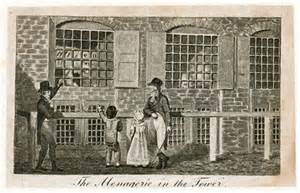
Visiting the Tower Menagerie, circa 1820
Source: The Tower Menagerie by Daniel Hahn
Tidbit #17-The Art of a Lady's Fan
A lady's fan came in handy when the galas and balls they attended were crushed with people and their body odors. While Beau Brummel made cleanliness fashionable, not everyone subscribed to bathing, opting instead to conceal their smells with perfumes which only added to their offense. The fan allowed a lady to diminish the stench without embarrassing the culprit and to create a revitalizing breeze. In addition, her fluttering fan drew the attention of gentlemen and with some well-learned motions, she could communicate with them using a silent language. A Spaniard by the name of Fenella is credited with creating the code that, at the time, allowed engaged couples under the scrutiny of their duennas to share their thoughts with one another. Frau Batholomaus published a booklet of the fan language in German and later M. J. Duvelleroy of Paris published a copy for England. Manufacturers hoping to profit from the trend, produced fans with the alphabet printed on them, but the system was too complicated to use and never found success. Below are a few of the simple fan movements that are reportedly used and what they mean.
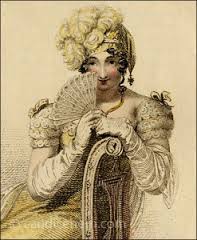
Twirling the fan in the left hand: We are watched.
Carrying the fan in the right hand in front of the face: Follow me.
Drawing the fan across the check: I love you.
Drawing the fan through the hand: I hate you
Covering the left ear with the open fan: Do not betray our secret.
Source: History of the Fan by G. Woolliscroft Rhead, Chapter One, p. 136-137, and The Fan by Valerie Steele, p. 13.
Tidbit #18-The Grand Tour
It was a common practice for the aristocracy to ship their young sons from Dover to Calais to embark on a Grand Tour of the continent. These young men carried letters of credit and introduction to welcome them into the foreign society of politics, diplomats, and fashion. They traveled in splendor with the means to purchase whatever caught their eye, often returning home with a collection of sculpture, paintings, and other memorabilia to decorate their future homes. Depending on what the gentleman's family could afford, their trip could last anywhere from one to five years. Armed (at least) with a tutor, (referred to as a bear-leader) they were expected to round out their education by visiting historical sites, museums and churches; gain some life experience; and polish their social manners by attending the theatres, clubs and galas hosted by the cosmopolitan courts, salons and noble houses of the Continent. They traveled first through France, where they purchased the latest in fashion, honed the language, improved their fencing and swordsmanship; learned deportment, ballroom dancing, and anything else that made them stylish. In Italy, they admired Palladio's architecture, the Italian marbles, Roman antiquity, and the master paintings of the Renaissance. In Venice they practiced their newly learned social graces at masked balls and then they continued onto Germany, Switzerland, Brussels, and The Netherlands. The Napoleonic war interrupted the British from taking their Grand Tours, but they embarked again the minute England won the Battle at Waterloo.
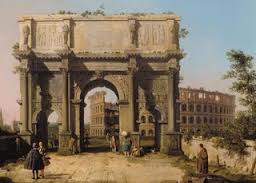
The Colosseum, Rome,Italy-18th Century
Source: The Grand Tour by Geoffrey Tease, The Age of George III by R. J. White , Chapter 13
Tidbit #19-What are Press Gangs?
During the Napoleonic Wars, Britain had a hard time recruiting seamen to serve in the Royal Navy where only officers benefited from prize money. There was little incentive to serve. Life aboard ship was hard work, severe discipline, poor food, and menial pay. However, impressment was a precedent that Parliament had no qualms to implement in order to man their warships. Press gangs were made up of two to twenty men who prowled the harbor taverns, or other gathering spots with their clubs and cutlasses to abduct as many able-bodied seamen they could find. Their tactics were ruthless, as their motivation was the coin they earned. Their view of an able-bodied seaman was flexible, so any man between the age of 18 and 55 was at risk when the press gangs went hunting. Even though property owners were suppose to be exempt, history books are filled with stories of unwilling men, from vagrants to men of means, who were cudgeled, handcuffed, put into a rowboat and placed in the hold of a frigate to serve their country.
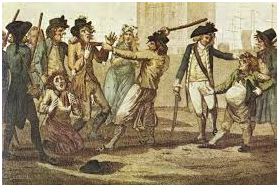
"Attic Miscellany. Manning the Navy" S. Collings 1790
Source: Dr. Johnson's London by Liza Picard p. 110-112
Men of War, Life in Nelson's Navy by Patrick O'Brian p, 57-59
IIn These Times. Living in Britain Through Napoleon's Wars, 1793-1815 by Jenny Uglow p. 59-60
Tidbit #20-Grog
For centuries, beer was a staple item aboard British Navy ships and was rationed to sailors to boost ship moral until Britain captured Jamaica from Spain in 1655 and discovered rum. The rum was rationed twice a day to seamen and became a problem for officers when crewmen became drunk and disobedient. Admiral Edward Vernon addressed the problem in 1740 by diluting the sailor's daily rum ration with water. The seamen called the drink Grog, after the admiral who was nicknamed Old Grog because he wore an odd coat of Grogram, a stiff and coarse material made of silk, mohair, and wool. Seamen referred to anyone that still felt the effects of the daily tot of rum the next day as being groggy. Britain's Navy ration continued until 1970 when the House of Commons in what has become known as the "Great Rum Debate," argued over the continuance of the ration. Voices for the appeal argued that their seamen's efficiency and skill in operating the navy's complex equipment was diminished under the liquor's influence. A quick vote discontinued the rum allotment and on July 31, 1970, known in the Royal Navy as Black Tot Day, seamen received their last tot of rum.
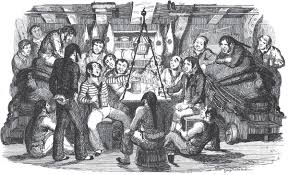
"Saturday Night at Sea" George Cruikshank 1841
Source: British Sea power by David Howath, p.245.
http://news.bbc.co.uk/ hi/today/ newsid_8859000/8859506.stom
hhtps://blog.distiller.com/rum-sea-history-grog/
:Tidbit #21-Foxhunting
Gentlemen turned their attention to the wily fox for sport around the middle of the eighteenth century when the enclosure of common land began to diminish England’s deer population. Before then, the hunting of foxes was associated with the lower sections of society who received awards by their local parishes to destroy them until sports enthusiasts made foxhunting a national winter past time. Unlike deer hunting where the goal was to find and kill the deer, foxhunting was all about the chase. Gentlemen loved to have their horsemanship and daredevil skills tested by racing across grassland and jumping hedgerows and other natural barriers to race after the fox. By the early 19th century, the modern foxhunt was all about fast horses, fast hounds, and a wily fox. Thoroughbred horses became the mount of choice, and foxhounds were bred for speed and stamina. The private sport soon turned into a public one, with proceedings to abide by, when people began to travel from other regions to join the hunt.
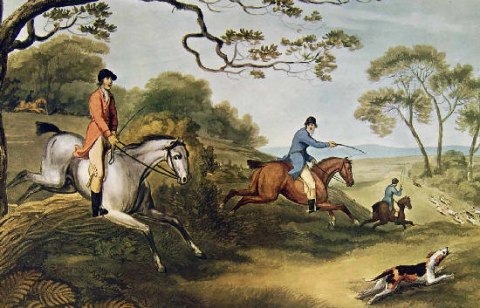
Source: From the Deer to the Fox. The hunting transition and the landscape 1600-1850 by Mandy de Belin Chapter 4
Tidebit #22: Dueling
Dueling has gone on for centuries. Kings allowed their knights to settle their disputes on the jousting field to let divine oversight, where God saw right triumphed, settle the matter. The notion the victor of the battle was "right and just" continued and by the seventeenth century, knights jousting for glory were replaced by gentlemen dueling for honor.
A gentleman's honor and that of his family were sacred. Any man sullying either of them was called to account else the slander was accepted as truth. The injured gentleman had no choice but to challenge the accuser to a duel, lest he and his family be slurred upon or caste out of polite society. Duels were the only way for a gentleman to retrieve his reputation among his peers. The same was true for the accuser, lest he be called a liar and coward. Be it swords or dueling pistols, blood would be drawn to determine the just. While a master swordsman could control where he inflicted a wound, pistols were not precise and usually resulted in the death if not one, then both combatants; unless the duelists missed their marks, their pistols misfired, or they deloped to satisfy honor and walk away unharmed.
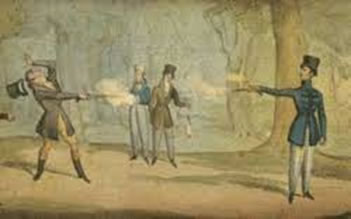
Sources: Gentlemen’s Blood by Barbara Holland ; The Duel by Robert Baldick; The Duelling Handbook by Joseph Hamilton